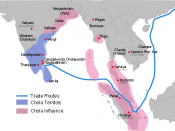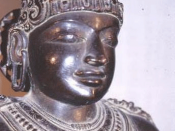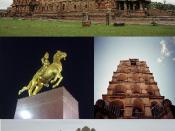This essay throws an insight into the marvellous architechture during the which has withstood the ravages of times.
Only two samples of the Chola architecture is introduced here in.
Chola Architecture
Introduction:
Art and architecture flourished well in India particularly in the river course. One such period of architectural creations was the Chola period. One could see marvelous temples, monolithic pillars and beautiful sculptures if you could travel down south in India in the areas of Tanjore, Trichy and Kumbakonam. Nature too blesses the visitors with a bountiful feast to your eyes.
The Chola Period:
Medieval south India saw resurgence in religious experience culminating in the great temple art of the Cholas. Time and again, both in architecture and sculpture, it is the artists' feeling for form and visual design that is reflected. What were the causes that went into the making of this inimitable Chola style? Prevalent consensus of opinions is based on the archaeological perceptions of influences from neighboring kingdoms and of a transition caused by religion nature, and political factors.
The early Cholas reigned between the 1st and 4th century AD and the first and most famous king of this period was Karikalan. What remains of his reign today is the magnificent civil engineering achievement of the Grand Anicut, which was constructed during the 2nd century and is used even to this day. This is built across the river Cauvery
Chola monarchs commissioned majestic temples and elegant sculptures to proclaim their power, wealth, and piety. The most enduring aspect of the four-century rule of the Cholas was the extensive temple building they undertook, creating a sacred circuit of 108 Shiva temples in the Kaveri Delta. The most celebrated Saiva temple of all, appropriately called Brihadisvara and Daksinameru, is the grandest creation of the Chola emperor Rajaraja (AD 985-1012). It was inaugurated by the king himself in his 19th regal year (AD 1009-10) and named it after himself as "Rajesvara Peruvudaiyar". Brahadeeswara Temple at Tanjore (Thanjavur), also called the Big Temple, belongs to the architecture of the Chola period. Built in the 10th Century A.D., by Raja Raja Chola, the Temple Tower is capped by an 81.3 tonnes round monolithic cupola. This enormous piece of stone is said to have been was moved into position by moving it along an inclined plane 6 kms. long. The temple is considered an engineering skill of the Chola architects who planned its construction in such a way that the shadow of the cupola never falls on the ground.
Now the Chola rulers are remembered most for what they created rather than for what they conquered. Chola rulers were active patrons of the arts, and during their reign, poetry, drama, music, and dance flourished. Every stone was turned into an artistic masterpiece, which has withstood time and depicts architectural intelligence. The sculptors are feast to eyes and soothers to soul.


